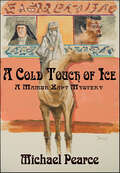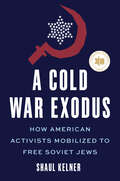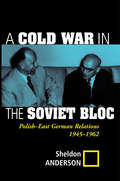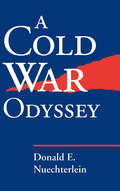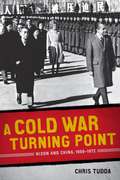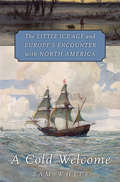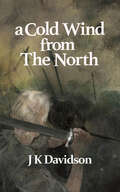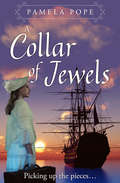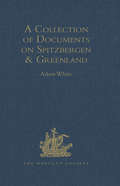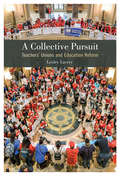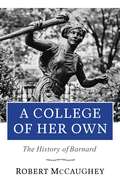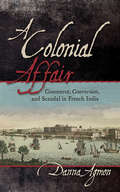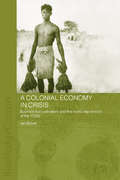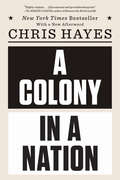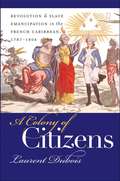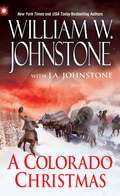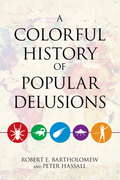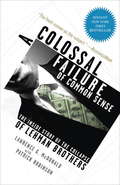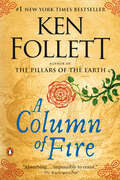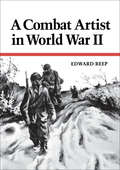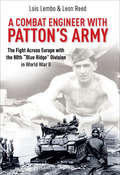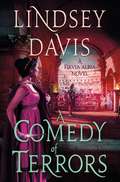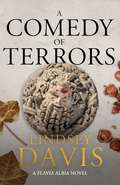- Table View
- List View
A Cold Touch of Ice (Mamur Zapt Mysteries #13)
by Michael PearceThe world is changing around the Mamur Zapt, British Chief of Cairo's Secret Police. It's 1912 and there's a war on that no one's heard of. When an Italian man is murdered in the city's back streets, there is concern that this could be some kind of ethnic cleansing. "One of us" Morelli may have been, but was he "one of us" enough? And were the guns in his warehouse anything to do with it? Gareth Owen - the Mamur Zapt - has to find out fast.And then, as external pressures crowd in, other difficult questions arise. What is Trudi von Ramsberg really doing in Cairo? Not to mention that other noted traveller, Gertrude Bell, or the irritating little archaeologist, T.E. Lawrence? And why has the post of Khedive's Librarian suddenly become so important?As Cromer's Egypt gives way to Kitchener's Egypt, Morelli is not the only one who has problems over where his allegiance lies. Maybe the solution is for Owen to go to Zanzibar....
A Cold War Exodus: How American Activists Mobilized to Free Soviet Jews
by Shaul KelnerWinner of The 74th National Jewish Book Award: American Jewish Studies Celebrate 350 AwardReveals the mass mobilization tactics that helped free Soviet Jews and reshaped the Jewish American experience from the Johnson era through the Reagan–Bush yearsWhat do these things have in common? Ingrid Bergman, Passover matzoh, Banana Republic®, the fitness craze, the Philadelphia Flyers, B-grade spy movies, and ten thousand Bar and Bat Mitzvah sermons? Nothing, except that social movement activists enlisted them all into the most effective human rights campaign of the Cold War.The plight of Jews in the USSR was marked by systemic antisemitism, a problem largely ignored by Western policymakers trying to improve relations with the Soviets. In the face of governmental apathy, activists in the United States hatched a bold plan: unite Jewish Americans to demand that Washington exert pressure on Moscow for change.A Cold War Exodus delves into the gripping narrative of how these men and women, through ingenuity and determination, devised mass mobilization tactics during a three-decade-long campaign to liberate Soviet Jews—an endeavor that would ultimately lead to one of the most significant mass emigrations in Jewish history.Drawing from a wealth of archival sources including the travelogues of thousands of American tourists who smuggled aid to Russian Jews, Shaul Kelner offers a compelling tale of activism and its profound impact, revealing how a seemingly disparate array of elements could be woven together to forge a movement and achieve the seemingly impossible. It is a testament to the power of unity, creativity, and the unwavering dedication of those who believe in the cause of human rights.
A Cold War In The Soviet Bloc: Polish-east German Relations, 1945-1962
by Sheldon AndersonIn A Cold War in the Soviet Bloc, Sheldon Anderson uses recently declassified documents from Polish and East German communist party and foreign ministry archives to examine the interplay of national interests with the exigencies of communist party relations within the Soviet bloc during the Cold War. Anderson explores how Polish-East German relations were strained over the permanence of the Oder-Neisse border, the correct road to socialism, German repatriation from Poland, and trade policy; he provides an inside account of the heated debates that seriously divided the Polish and East German communists.Anderson delves into how and why the rift culminated in the return of the anti-Stalinist Wladyslaw Gomulka in October 1956, and he delineates how the Polish-East German conflict undermined the unity of the Soviet bloc on its most strategic flank. In doing so, he reveals the persistence of nationalism and ethnic prejudice in the former communist countries. In this timely text, Anderson pinpoints how nationalism has reemerged as a powerful political force following the end of the Cold War. With A Cold War in the Soviet Bloc, Anderson markedly fills the gap in the existing scholarship on postwar relations between the countries of East Europe.
A Cold War Odyssey
by Donald E. Nuechterlein“A fascinating ride through a period of history in which United States foreign policies and relationships matured greatly.” —Ralph C. Bledsoe, Special Assistant to the President, 1982–88The Cold War—that long ideological conflict between the world’s two superpowers—had a profound effect not only on nations but on individuals, especially all those involved in setting and implementing the policies that shaped the struggle. Donald Nuechterlein was one such individual and this is his story.Although based in fact, the narrative reads like fiction, and it takes the reader behind the scenes as no purely factual telling of that complex story can. Presented as the story of David and Helen Bruening and their family, A Cold War Odyssey carries us across three continents. Against a backdrop of national and international events, we follow the Bruenings through five decades as David’s governmental and academic assignments take them to all corners of the world.In the tradition of Herman Wouk’s Winds of War, the Bruenings’ personal and professional odyssey offers us a microcosm of world history in the second half of the twentieth century. Through the acute eyes of these participant observers, we see the partitioning of Europe after World War II, Korea and Vietnam, Watergate and Iran, the fall of the Berlin Wall and the reunification of Germany, the collapse of the Soviet Union and, with it, the end of the Cold War. With each succeeding episode, our understanding of the causes and consequences of international struggle is deepened through the Bruenings’ experience.
A Cold War Turning Point: Nixon And China, 1969-1972
by Chris TuddaIn February 1972, President Nixon arrived in Beijing for what Chairman Mao Zedong called the "week that changed the world. " Using recently declassified sources from American, Chinese, European, and Soviet archives, Chris Tudda's A Cold War Turning Point reveals new details about the relationship forged by the Nixon administration and the Chinese government that dramatically altered the trajectory of the Cold War. Between the years 1969 and 1972, Nixon's national security team actively fostered the U. S. rapprochement with China. Tudda argues that Nixon, in bold opposition to the stance of his predecessors, recognized the mutual benefits of repairing the Sino-U. S. relationship and was determined to establish a partnership with China. Nixon believed that America's relative economic decline, its overextension abroad, and its desire to create a more realistic international framework aligned with China's fear of Soviet military advancement and its eagerness to join the international marketplace. In a contested but calculated move, Nixon gradually eased trade and travel restrictions to China. Mao responded in kind, albeit slowly, by releasing prisoners, inviting the U. S. ping-pong team to Beijing, and secretly hosting Secretary of State Henry Kissinger prior to Nixon's momentous visit. Set in the larger framework of international relations at the peak of the Vietnam War, A Cold War Turning Point is the first book to use the Nixon tapes and Kissinger telephone conversations to illustrate the complexity of early Sino-U. S. relations. Tudda's thorough and illuminating research provides a multi-archival examination of this critical moment in twentieth-century international relations.
A Cold War Turning Point: Nixon and China, 1969-1972
by Chris TuddaIn February 1972, President Nixon arrived in Beijing for what Chairman Mao Zedong called the "week that changed the world." Using recently declassified sources from American, Chinese, European, and Soviet archives, Chris Tudda's A Cold War Turning Point reveals new details about the relationship forged by the Nixon administration and the Chinese government that dramatically altered the trajectory of the Cold War. Between the years 1969 and 1972, Nixon's national security team actively fostered the U.S. rapprochement with China. Tudda argues that Nixon, in bold opposition to the stance of his predecessors, recognized the mutual benefits of repairing the Sino-U.S. relationship and was determined to establish a partnership with China. Nixon believed that America's relative economic decline, its overextension abroad, and its desire to create a more realistic international framework aligned with China's fear of Soviet military advancement and its eagerness to join the international marketplace. In a contested but calculated move, Nixon gradually eased trade and travel restrictions to China. Mao responded in kind, albeit slowly, by releasing prisoners, inviting the U.S. ping-pong team to Beijing, and secretly hosting Secretary of State Henry Kissinger prior to Nixon's momentous visit. Set in the larger framework of international relations at the peak of the Vietnam War, A Cold War Turning Point is the first book to use the Nixon tapes and Kissinger telephone conversations to illustrate the complexity of early Sino-U.S. relations. Tudda's thorough and illuminating research provides a multi-archival examination of this critical moment in twentieth-century international relations.
A Cold Welcome: The Little Ice Age and Europe’s Encounter with North America
by Sam WhiteWhen Europeans arrived in North America, the average global temperature had dropped to lows unseen in millennia and its effects—famine, starvation, desperation, and violence—were stark among colonists unprepared to fend for themselves. This history of the Little Ice Age in North America reminds us of the risks of a changing and unfamiliar climate.
A Cold Wind From The North
by J K DavidsonIn seventh century Wales, a young man must fight to prove himself. As the kingdoms of post-Roman Britain struggle for a new order, his chieftain father is called away to war and Rhun is left to care for his people. But soon he is tasked with a dangerous mission of his own. Gathering a small band of friends, he sets out into the unknown to face a deadly enemy, battle, and death.
A Collar of Jewels (Magna Large Print Ser.)
by Pamela PopeAbandoned by her husband in England, a desperate woman struggles to build a new life for herself . . . Born into a wealthy English family and raised in Chicago, Ellie is used to a life of luxury. When she met Max Berman, it was the best thing that had ever happened to her, but her father, president of the Union Atlantic Railroad Company, was absolutely against a marriage to the son of Russian Jews. Still, Ellie was determined to be with the man she loved—even if it meant sacrificing her fortune. Ellie and Max, along with their four-month-old son, William, journey across the Atlantic to Southampton, England to start a new life. Max, goes off to sort out the immigration papers, while Ellie waits with William and the luggage. But then more than several minutes pass, and the crowds have died down. He’s nowhere in sight. Then, a porter gives Ellie the shocking news that Max was seen boarding the ship returning to America . . . Desperate and penniless, Ellie seeks out her English grandfather, Sir Robert Cromer. Finding her way on her own will be a struggle—and so will banishing Max from her heart. But for the sake of her son, and herself, she is determined never to be at the mercy of a man again . . .
A Collection of Documents on Spitzbergen and Greenland: Comprising a translation from F. Martens' Voyage to Spitzbergen: a Translation from Isaac de la Peyrère's Histoire du Groenland: and God's Power and Providence in the Preservation of Eight Men in Greenland Nine Months and Twelve Days (Hakluyt Society, First Series)
by Adam WhiteThe first text is from an English collection published in 1694; the second from the Relation du Groenland, Paris, 1663; the third is the text of Edward Pelham's tract, London, 1631. The supplementary material consists of the 1855 annual report. This is a new print-on-demand hardback edition of the volume first published in 1855.
A Collective Pursuit: Teachers' Unions and Education Reform
by Lesley LaveryTeachers’ unions are the organizations responsible for safeguarding the conditions of teachers’ employment. Union supporters claim strong synergies between teachers’ interests and students’ interests, but critics of unions insist that the stance of teachers in collective bargaining may disadvantage students as unions reduce the power of administrators to manage, remove, reward or retain excellent teachers. In A Collective Pursuit, Lesley Laveryunpacks how teachers’ unions today are fighting for contracts that allow them to earn a decent living and build “schools all students deserve.” She explains the form and function of the nation’s largest teachers’ unions. Lavery then explores unionization campaigns in the Twin Cities charter schools. A Collective Pursuit also examines teacher strikes and contract negotiations, school finance and finance reform, and district and union attempts to address racial achievement gaps, to provide a context for understanding the economic, political, and demographic forces that inspire teachers to improve conditions for students. A Collective Pursuit emphasizes that while teachers’ unions serve a traditional, economic role, they also provide a vast array of valuable services to students, educators, parents, and community members.
A College of Her Own: The History of Barnard (Columbiana)
by Robert McCaugheyIn 1889, Annie Nathan Meyer, still in her early twenties, led the effort to start Barnard College after Columbia College refused to admit women. Named after a former Columbia president, Frederick Barnard, who had advocated for Columbia to become coeducational, Barnard, despite many ups and downs, became one of the leading women’s colleges in the United States.A College of Her Own offers a comprehensive and lively narrative of Barnard from its beginnings to the present day. Through the stories of presidents and leading figures as well as students and faculty, Robert McCaughey recounts Barnard’s history and how its development was shaped by its complicated relationship to Columbia University and its New York City location. McCaughey considers how the student composition of Barnard and its urban setting distinguished it from other Seven Sisters colleges, tracing debates around class, ethnicity, and admissions policies. Turning to the postwar era, A College of Her Own discusses how Barnard benefited from the boom in higher education after years of a precarious economic situation. Beyond the decisions made at the top, McCaughey examines the experience of Barnard students, including the tumult and aftereffects of 1968 and the impact of the feminist movement. The concluding section looks at present-day Barnard, the shifts in its student body, and its efforts to be a global institution. Informed by McCaughey’s five decades as a Barnard faculty member and administrator, A College of Her Own is a compelling history of a remarkable institution.
A Colonial Affair: Commerce, Conversion, and Scandal in French India
by Danna AgmonDanna Agmon's gripping microhistory is a vivid guide to the "Nayiniyappa Affair" in the French colony of Pondicherry, India. The surprising and shifting fates of Nayiniyappa and his family form the basis of this story of global mobilization, which is replete with merchants, missionaries, local brokers, government administrators, and even the French royal family.Agmon's compelling account draws readers into the social, economic, religious, and political interactions that defined the European colonial experience in India and elsewhere. Her portrayal of imperial sovereignty in France's colonies as it played out in the life of one beleaguered family allows readers to witness interactions between colonial officials and locals. Thanks to generous funding from Virginia Tech and its participation in TOME, the ebook editions of this book are available as Open Access volumes, available from Cornell Open (cornellopen.org) and other repositories.
A Colonial Economy in Crisis: Burma's Rice Cultivators and the World Depression of the 1930s (Routledge Studies in the Modern History of Asia #Vol. 28)
by Ian BrownThe book challenges the orthodox argument that rural populations which abandoned self-sufficiency to become single commodity producers, and were supposedly very vulnerable to the commodity price collapse of the 1930s Depression, did not suffer as much as has been supposed. It shows how the effects of the depression were complicated, varying between regions, between different kinds of economic actors, and over time, and shows how the 'victims' of the depression were not passive, working imaginatively to mitigate their circumstances.
A Colonial Plantation Cookbook: The Receipt Book of Harriott Pinckney Horry, 1770
by Richard J. Hooker“A charming compilation of eighteenth-century recipes . . . a well-researched account of Mrs. Horry’s fascinating life-style.” —The North Carolina Historical ReviewHarriott Pinckney Horry began her receipt book more than two hundred years ago. It is being published now for the first time.You will get a lively sense of what colonial plantation life was like from reading Harriott’s receipt book. She began it in 1770, shortly after she was married, writing recipes and household information in a notebook. Her recipes reflect both English and French culinary traditions. You will recognize in the recipes the origins of some of your contemporary favorites.Harriott writes also about keeping the dairy and smokehouse, how to dye clothes, what to do about insects, how to care for trees and crops, and how to make soap, all skills she learned in the course of managing the plantation after her husband’s early death.From Harriott’s writing and Hooker’s knowledgeable introduction and editorial notes, you will learn what it was like to be well-to-do and a member of Southern aristocracy, living in a world of rice and indigo planters, merchants, lawyers, and politicians—the colonial elite. Because knowing about food preferences and eating habits of any people expands our understanding of their nature and times, the receipt book of Harriott Pinckney Horry opens another window on the history of colonial plantations.“Gives us a very good idea of the household’s prize dishes.” —The Washington Post“Cookbook collectors will love it and even readers who don’t enter the kitchen will find it entertaining.” —The Charleston Evening Post
A Colony in a Nation
by Chris Hayes<P>New York Times best-selling author and Emmy Award–winning news anchor Chris Hayes argues that there are really two Americas: a Colony and a Nation. <P>America likes to tell itself that it inhabits a postracial world, yet nearly every empirical measure—wealth, unemployment, incarceration, school segregation—reveals that racial inequality has barely improved since 1968, when Richard Nixon became our first “law and order” president. With the clarity and originality that distinguished his prescient bestseller, Twilight of the Elites, Chris Hayes upends our national conversation on policing and democracy in a book of wide-ranging historical, social, and political analysis. <P>Hayes contends our country has fractured in two: the Colony and the Nation. In the Nation, we venerate the law. In the Colony, we obsess over order, fear trumps civil rights, and aggressive policing resembles occupation. A Colony in a Nation explains how a country founded on justice now looks like something uncomfortably close to a police state. How and why did Americans build a system where conditions in Ferguson and West Baltimore mirror those that sparked the American Revolution? <P>A Colony in a Nation examines the surge in crime that began in the 1960s and peaked in the 1990s, and the unprecedented decline that followed. Drawing on close-hand reporting at flashpoints of racial conflict, as well as deeply personal experiences with policing, Hayes explores cultural touchstones, from the influential “broken windows” theory to the “squeegee men” of late-1980s Manhattan, to show how fear causes us to make dangerous and unfortunate choices, both in our society and at the personal level. With great empathy, he seeks to understand the challenges of policing communities haunted by the omnipresent threat of guns. Most important, he shows that a more democratic and sympathetic justice system already exists—in a place we least suspect. <P>A Colony in a Nation is an essential book—searing and insightful—that will reframe our thinking about law and order in the years to come. <P><b>A New York Times Bestseller</b>
A Colony of Citizens: Revolution & Slave Emancipation in the French Caribbean, 1787-1804
by Laurent Dubois<P>The idea of universal rights is often understood as the product of Europe, but as Laurent Dubois demonstrates, it was profoundly shaped by the struggle over slavery and citizenship in the French Caribbean. Dubois examines this Caribbean revolution by focusing on Guadeloupe, where, in the early 1790s, insurgents on the island fought for equality and freedom and formed alliances with besieged Republicans. <P> In 1794, slavery was abolished throughout the French Empire, ushering in a new colonial order in which all people, regardless of race, were entitled to the same rights. But French administrators on the island combined emancipation with new forms of coercion and racial exclusion, even as newly freed slaves struggled for a fuller freedom. In 1802, the experiment in emancipation was reversed and slavery was brutally reestablished, though rebels in Saint-Domingue avoided the same fate by defeating the French and creating an independent Haiti. The political culture of republicanism, Dubois argues, was transformed through this transcultural and transatlantic struggle for liberty and citizenship. The slaves-turned-citizens of the French Caribbean expanded the political possibilities of the Enlightenment by giving new and radical content to the idea of universal rights.
A Colorado Christmas
by William W. Johnstone J. A. JohnstoneTHE GREATEST WESTERN WRITERS OF THE 21ST CENTURY At the Sugarloaf Ranch, Smoke and Sally Jensen prepare to welcome Preacher home for the holidays--unaware that their friend is trailed by a storm full of trouble. On a mission of vengeance, an old trapper is rescued by Ace and Chance Jensen from ruthless outlaws--and wanted by a driven bounty hunter named Luke Jensen. And, just released from prison, a criminal mastermind assembles a vicious gang of cutthroats to extract his final revenge against his enemy--the sheriff of Big Rock, Colorado . . . With a snowstorm brewing, a community in jeopardy, and a showdown ready to explode, these courageous pioneers are brought together by fate and fury to forge peace on earth. But they're going to have to fight for it. With guns. With grit. With glory. Because this Christmas, the greatest gift of all is . . . staying alive.RAVES FOR BUTCH CASSIDY THE LOST YEARS!"Johnstone is a masterful storyteller, creating a tale that is fanciful and funny, exciting and surprisingly convincing. This is great fun."--Publishers Weekly"An entertaining story with lots of plot twists."--BooklistRAVES FOR JOHNSTONE'S CHRISTMAS EPICS!"An absorbing tale of Christmas with a side of magic . . . An exciting visit to the old west of gunfights and cattle drives. Four stars!"-- RT Book Reviews on A Rocky Mountain Christmas"This is an exciting visit to the old west of gunfights and cattle drives . . . the story draws one in and the modern world fades away. An absorbing tale of Christmas with a side of magic. Four stars!"--RT Book Reviews on A Lone Star Christmas"This rollicking Western is full of gunfights, outlaws, and an unforgettable holiday."--Library Journal on A Texas Hill Country Christmas
A Colorful History of Popular Delusions
by Robert E. Bartholomew Peter HassallThis eclectic history of unusual crowd behavior describes a rich assortment of mass phenomena ranging from the amusing and quirky to the shocking and deplorable. What do fads, crazes, manias, urban legends, moral panics, riots, stampedes, and other mass expressions of emotion have in common? By creating a typology of such behavior, past and present, the authors show how common extraordinary group reactions to fear or excitement are. And they offer insights into how these sometimes dangerous mob responses can be avoided. We may not be surprised to read about the peculiarities of the European Middle Ages, when superstition was commonplace: like the meowing nuns of France, "tarantism" (a dancing mania) in Italy, or the malicious anti-Semitic poison-well scares. But similar phenomena show up in our own era. Examples include the social-networking hysteria of 2012, which resulted in uncontrollable twitching by teenage girls in Leroy, NY; the "phantom bus terrorist" of 2004 in Vancouver, Canada; and the itching outbreak of 2000 in South Africa. Vivid, detailed, and thoroughly researched, this is a fascinating overview of collective human behavior in its many unusual forms.From the Trade Paperback edition.
A Colossal Failure of Common Sense: The Inside Story of the Collapse of Lehman Brothers
by Patrick Robinson Lawrence G. McDonaldOne of the biggest questions of the financial crisis has not been answered until now: What happened at Lehman Brothers and why was it allowed to fail, with aftershocks that rocked the global economy? In this news-making, often astonishing book, a former Lehman Brothers Vice President gives us the straight answers—right from the belly of the beast. In A Colossal Failure of Common Sense, Larry McDonald, a Wall Street insider, reveals, the culture and unspoken rules of the game like no book has ever done. The book is couched in the very human story of Larry McDonald&’s Horatio Alger-like rise from a Massachusetts &“gateway to nowhere&” housing project to the New York headquarters of Lehman Brothers, home of one of the world&’s toughest trading floors. We get a close-up view of the participants in the Lehman collapse, especially those who saw it coming with a helpless, angry certainty. We meet the Brahmins at the top, whose reckless, pedal-to-the-floor addiction to growth finally demolished the nation&’ s oldest investment bank. The Wall Street we encounter here is a ruthless place, where brilliance, arrogance, ambition, greed, capacity for relentless toil, and other human traits combine in a potent mix that sometimes fuels prosperity but occasionally destroys it. The full significance of the dissolution of Lehman Brothers remains to be measured. But this much is certain: it was a devastating blow to America&’s—and the world&’s—financial system. And it need not have happened. This is the story of why it did.
A Column of Fire: A Novel (Kingsbridge #3)
by Ken Follett<P>International bestselling author Ken Follett has enthralled millions of readers with The Pillars of the Earth and World Without End, two stories of the Middle Ages set in the fictional city of Kingsbridge. <P>The saga now continues with Follett’s magnificent new epic, A Column of Fire. In 1558, the ancient stones of Kingsbridge Cathedral look down on a city torn apart by religious conflict. As power in England shifts precariously between Catholics and Protestants, royalty and commoners clash, testing friendship, loyalty, and love. <P> Ned Willard wants nothing more than to marry Margery Fitzgerald. But when the lovers find themselves on opposing sides of the religious conflict dividing the country, Ned goes to work for Princess Elizabeth. When she becomes queen, all Europe turns against England. The shrewd, determined young monarch sets up the country’s first secret service to give her early warning of assassination plots, rebellions, and invasion plans. <P>Over a turbulent half century, the love between Ned and Margery seems doomed as extremism sparks violence from Edinburgh to Geneva. Elizabeth clings to her throne and her principles, protected by a small, dedicated group of resourceful spies and courageous secret agents. <P>The real enemies, then as now, are not the rival religions. The true battle pitches those who believe in tolerance and compromise against the tyrants who would impose their ideas on everyone else—no matter what the cost. <P>Set during one of the most turbulent and revolutionary times in history, A Column of Fire is one of Follett’s most exciting and ambitious works yet. It will delight longtime fans of the Kingsbridge series and is the perfect introduction for readers new to Ken Follett. <P><b>A New York Times Bestseller</b>
A Combat Artist in World War II
by Edward ReepA WWII combat artist shares his recollections—and his arresting artwork—from the frontlines of the Italian campaign in this military memoir.Many artists have fought in wars and later recorded heroic scenes of great battles. Yet few artists have created their work on the frontlines as they fought alongside their comrades. Edward Reep, as an official combat artist in World War II, painted and sketched while the battles of the Italian campaign raged around him. At Monte Cassino, the earth trembled as he attempted to paint the historic bombing of that magnificent abbey. Later, racing into Milan with armed partisans on the fenders of his Jeep, he saw the bodies of Mussolini and his beautiful mistress cut down from the gas station where they had been hanged by their heels. That same day he witnessed the spectacle of a large German army force holed up in a high-rise office tower, waiting for the chance to surrender to the proper American brass for fear of falling into the hands of the vengeful partisans.Reep’s recollections of such desperate days are captured in Combat Artist, both in the text and in the many painfully vivid paintings and drawings that accompany it. Reep’s battlefield drawings show us, with unrelenting honesty, the horrors and griefs?and the bitter comedy?of battle.
A Combat Engineer with Patton's Army: The Fight Across Europe with the 80th "Blue Ridge" Division in World War II
by Lois Lembo Leon ReedGeorge Patton is renowned for his daring tank thrusts and rapid movement, but the many rivers and obstacles his Third Army encountered crossing Europe required engineers spearheading his advance. A Combat Engineer with Patton’s Army is the untold story of Frank Lembo, one of Patton’s men who helped move the American command in the battle of Argentan in the Normandy Campaign, in the high-speed pursuit of the German Wehrmacht eastward across France, and in the brutal battles waged during the Battle of the Bulge and during the final combats along the borders of the collapsing Reich. Throughout his time in Europe Lembo maintained a running commentary of his experiences with Betty Craig, his fiancé and future wife. This extensive correspondence provides a unique eyewitness view of the life and work of a combat engineer under wartime conditions. As a squad (and later platoon) leader, Frank and his comrades cleared mines, conducted reconnaissance behind enemy lines, built bridges, and performed other tasks necessary to support the movement of the 317th, 318th, and 319th Infantry Regiments of the Blue Ridge Division—Patton’s workhorses, if not his glamour boys. Frank wrote about the deadly river crossings at the Moselle, Seille, and Sauer, all under enemy fire, and of the frustrating pauses when supplies were diverted. He participated in the mid-December sprint to Luxembourg and the relief provided at Bastogne during the Bulge, the liberation of concentration camps once Third Army had charged into Germany, and of their occupation duty in Bavaria. Frank’s letters go beyond his direct combat experiences to include the camaraderie among the GIs, living conditions, weather, and the hijinks that helped keep the constant threat of death at bay. His letters also worked to reassure Betty with hopeful dreams for their future together. Including dozens of previously unpublished photographs, A Combat Engineer with Patton’s Army: The Fight Across Europe with the 80th “Blue Ridge” Division in World War II offers the rare perspective of what day-to-day warfare at the ground-level looked like in the European Theater through the eyes of one of the men spearheading the advance.
A Comedy of Terrors: A Flavia Albia Novel (Flavia Albia Series #9)
by Lindsey Davis"Melds scrupulous research, arch banter, caustic characters, and strong plotting...Flavia Albia is delightful, trickster-y company to spend time with." -- New York Times Book ReviewIn Rome, 89 A.D., poisonings, murders, and a bloody gang war of retribution breaks out during the festival of Saturnalia, and when her husband, Tiberius, becomes a target, it's time for Flavia Albia to take matters into her own hands -- in Lindsey Davis’s next historical mystery, A Comedy of Terrors. Flavia Albia, daughter and successor of private informer Marcus Didius Falco is twiddling her thumbs with no clients during the December festival of Saturnalia. But that doesn't mean all is quiet. Her husband Tiberius and the Fourth Cohort are battling organized crime interests that are going to war over the festival nuts. A series of accidental poisonings, then bloody murders of rival nut-sellers, and finally a gruesome warning to Tiberius from the hidden criminal powers to back off.Albia has had just about enough and combines forces with Tiberius to uncover the hidden criminal gangs trying to worm their way into the establishment at a banquet of the emperor Domitian.
A Comedy of Terrors: The Sunday Times Crime Club Star Pick (Flavia Albia #9)
by Lindsey Davis***The Sunday Times Crime Club Star Pick***'Lighthearted, witty and effortlessly clever, just like its wonderful heroine, this is a window into ancient Rome, and a tonic and a joy to read' The ObserverSaturnalia, the Romans' mid-December feast, nominally to celebrate the sun's rebirth but invariably a drunken riot. Flavia Albia needs a case to investigate, but all work is paused. The Aventine is full of fracturing families. Wives plot to leave their husbands, husbands plot to spend more time with their mistresses. Masters must endure slaves taking obscene liberties, while aggressive slaves are learning to ape dangerous masters. But no one wants to hire an investigator during the holiday. Albia is lumped with her own domestic stress: overexcited children and bilious guests, too many practical jokes, and her magistrate husband Tiberius preoccupied with local strife. He fears a Nut War. Nuts are both the snack and missile of choice of tipsy celebrants, so there is a fortune to be made. This year a hustling gang from the past is horning in on the action.As the deadly menace strikes even close to home, and with law and order paused for partying, Albia and Tiberius must go it alone. The Emperor has promised the people a spectacular entertainment - but Domitian himself is a target for the old criminals' new schemes. Can the Undying Sun survive the winter solstice, or will criminal darkness descend upon Rome?Praise for Lindsey Davis and the Flavia Albia series'For a totally exhilarating romp through Ancient Rome, Lindsey Davis' latest Flavia Alba novel won't be beaten and offers an immersive experience of a vibrant world full of real, recognisable characters' Shotsmag'In this witty novel by the mistress of Roman crime, the reader is transported behind the scenes of a Triumph into a fascinating world of actors, costumiers and animal trainers, all united in their hatred of the murdered man' Sunday Express Magazine'Davis does her usual brilliant job of integrating the history of the period, warts and all, with a fast-paced and fair whodunit' Publishers Weekly
